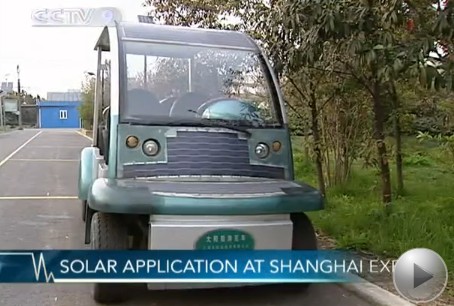|
|


ADVERTISEMENT
Buy Your own advertising
spaces!
.
Download Adobe Acrobat Reader to open [PDF] files.
Recent Visitors
Solar Application at Shanghai Expo
2010. 21 February
 Video:Click to the picture!
Video:Click to the picture!
(cctv.com)
The sun has long been a symbol of power and strength for all life on our planet. Solar energy is one of the most developed clean energy sources in the world. The 2010 Shanghai World Expo will see the greatest use of solar energy in the event's history.
Solar street-lamp, tourist car use solar energy, and even solar newsstand, we may see them all in the 2010 Shanghai World Expo Park. But as experiments, we can first see them here at city solar power application center.
This building fully takes solar energy to create electricity. It has been put into use since Sept 2005, and so far produced nearly 133-thousand kilowatt hour of electricity. The electricity it produces not only covers all the staff’s daily use; it can also supply superfluous power to the entire city power network.
Prof. Zhang Zhongwei, Shanghai Solar Energy S&T Company, said, "This is the first BIPV building in the city, also the first in the country. The capacity of this building’s solar power plant is 40 kilowatt. It is more than enough for our daily use. We can also cover all the electricity use in our entire application center area."
BIPV, namely Building Integrated Photovoltaic, refers to photovoltaic systems integrated with the building phase. The systems were initially included in the construction planning procedure and then usually build along with the building to supply its future electricity use.
In fact, BIPV technology will be widely used in the expo park. Three of the four permanent building structures in the Expo Park will take up this technology, to go inline with the expo theme.
Dr. Hao Guoqiang, Shanghai Solar Energy Research Center, said, "The theme of our expo is “better city better life.”
To use the renewable energy is a key element to a better city life, and the best practice of renewable energy is the solar technology.And the best practice of solar power in the city lies in BIPV. So we recommended BIPV technology to BIE at first place. The final decision is to take up BIPV technology in three of the four permanent buildings in Expo Park. The Theme Pavilion has a big flat surface, so its capacity of solar power can reach 2800 kilowatts. The China Pavilion is smaller in size, but it has different significance. Its solar power can reach 300 kilowatts. And the expo center reaches 1000 kilowatts."
Solar power has long being part of the displays in the expo history. Back at the 1982 Worlds’ fair in the Knoxville, Tennessee in the US, solar thermal collectors and other photovoltaic equipments have made their debut with expo theme “Energy turns the World”.
In 2000 Hanover Expo in Germany and 2005 Aichi Expo in Japan, solar power has also acted important role. Experts also predict that the use of solar power in 2010 Shanghai expo will be the most widely in expo history. Although we saw the quick development of the technology, most of them were brought by foreign countries. Why the technology is developing rather slowly in China, experts say the lack of proper standards is the key to this.
Dr. Hao Guoqiang, said, "The technology is still under forming in China. Because we still lack of many standards, no matter the standard for installation, or the testing standard."
The advantage of using solar power is obvious to every households, we save the coal for producing electricity, and cut carbon emission. And now with the joint effort from some of the world’s leading safety organizations and standard tester of photovoltaic systems come as part of the Expo, the concept of using solar power will definitely spread.
Experts say if 5 percent of Shanghai residents can install solar system, it will be able to satisfy all the Shanghai’s basic electricity needs. The country’s Ministry of Finance said in late March that China will provide 20 yuan subsidy per watt for BIPV cases that have capacity of more than 50 kilowatt. And this will cover around half of the installation costs. With this allowance and the heat of solar power in 2010, it is very likely to have a new cost-efficient clean city life in the near future.
Source:www.cctv.com

